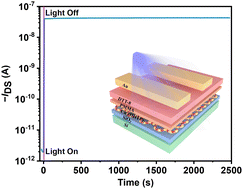Organic field-effect floating-gate transistors combine the advantages of organic semiconductor materials to produce more functionality by sensing changes in photogenerated carriers, allowing data to be stored efficiently. Herein, a novel metal–organic framework (MOF) floating gate optical memory transistor was engineered using a two-dimensional molecular crystal (2DMC) as the active layer via a layer-by-layer assembly technique. Highly uniform ultra-thin MOF films were synthesized at the gas–liquid interface and subsequently transferred to serve as the floating gate layer. The device exhibited a substantial memory window of 36 V upon optical pulse stimulation and maintained its performance without degradation after 100 cycles of optical programming and electrical erasure testing, demonstrating exceptional durability. Moreover, it displayed remarkable current-holding characteristics about 10 000 seconds under varying light intensities and achieved multi-level memory functionality with significant current differences. These findings substantiate its potential commercial viability in high-performance information memory devices.
